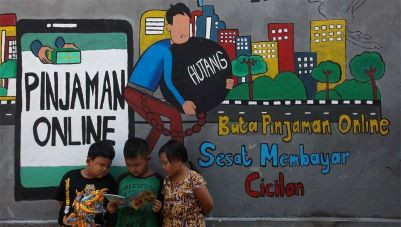Popular Reads
Top Results
Can't find what you're looking for?
View all search resultsPopular Reads
Top Results
Can't find what you're looking for?
View all search resultsBehavioral insights can fight unethical peer-to-peer lending practices
We cannot expect consumers to protect themselves since less than half of the population is considered financially literate.
Change text size
Gift Premium Articles
to Anyone
I
ndonesia has witnessed a significant growth in peer-to-peer (P2P) lending, with a total of Rp 241.56 trillion (US$15.09 billion) in P2P loans disbursed in 2023, marking a 7.1 percent increase from the year before. However, this growth has been accompanied by reports of predatory and unethical lending practices, including operators imposing sky-high interest rates and hidden fees.
While the government has implemented various measures to regulate P2P lending service operators, such as by requiring service operators to be registered with the Financial Services Authority (OJK) and the Indonesian Joint Funding Fintech Association (AFPI), blocking non-compliant apps and imposing a moratorium on new lending platform licenses, consumers continue to fall victim to unethical lending practices.
Implementing the right regulation is challenging. Limited resources can hinder enforcement, especially when market players outpace authorities. We cannot expect consumers to protect themselves, either, since less than half of the population is considered financially literate and financial education might not be enough to improve borrowers’ decisions.
On top of that, there are a range of cognitive and psychosocial factors that prevent people from using their knowledge to make well-planned decisions. Therefore, lending regulation must recognize that consumers are ill-equipped to protect themselves, and must consider how people actually think and behave, to enhance regulation effectiveness and complement existing policies in the financial sector.
Most public policy relies on the assumption that humans are rational agents, who gather complete information and make well-planned decisions. However, extensive behavioral science research strongly suggests that humans are easily influenced by cognitive biases and other factors in the environment when making everyday and even major (financial) decisions. This field of study can offer invaluable insights into why consumers may be susceptible to predatory lending practices.
For instance, consumers often face resource constraints and biases when choosing lending platforms. Limited time and information compel them to be satisfied with the seemingly acceptable option, rather than conducting a thorough comparison. If a platform meets their immediate needs, such as quick access to funds, they will be more likely to choose it without assessing factors such as interest rates and proof of registration, and stop looking for alternatives.
Consumers are also highly influenced by how information is presented, with visually appealing digital platforms seen as more credible. Mental shortcuts like this allow consumers to make quick decisions, however, they can sometimes be inaccurate and lead to poor judgments. Additionally, consumers react differently when presented with different price displays, often understanding and recalling absolute borrowing costs better than percentages.
Here are three actionable and simple ideas on how to help protect consumers from unethical lending practices using insights from behavioral science.
First, explicitly signal trustworthy platforms. While the lists of registered and unregistered platforms that have been regularly published is crucial to raise awareness, people may simply overlook or decide to not take this extra step when under pressure.
To mitigate this, the OJK and the Communications and Information Ministry could collaborate with application marketplaces to introduce salient cues such as blue ticks that show up alongside the list of apps, signaling regulatory compliance. This can help reduce the “hassle factor” associated with assessing credibility. Research shows that minimizing the hassle or perceived hassle associated with a behavior increases the likelihood of people doing it, such as identifying a trustworthy platform.
Second, create a central source of information on P2P lending. Having a comparison tool on a website to evaluate different platforms would serve as a decision aid by simplifying the process of comparing options. To help consumers tackle choice overload, the tool should ideally only include key information in the main view, employ color-coding and provide information on reasonable interest rates. Examples of existing comparison platforms include MoneySmart Singapore and MoneySuperMarket in the United Kingdom.
Third, require platforms to disclose all fees and penalties upfront, in absolute amounts instead of percentages. Studies show that when consumers do not see full costs upfront, they underestimate them, discontinue their search for alternatives and consequently settle for subpar deals.
Predatory P2P lending platforms often deliberately deceive consumers by not showing all the relevant fees, interest and penalty rates for their loan, leaving consumers surprised by the amount payable later on. By making all costs transparent from the start, consumers can accurately assess loan affordability and avoid hidden costs.
As Indonesia’s digital financial sector continues to grow, we should consider multifaceted approaches such as applying behavioral insights to enhance existing regulatory measures for consumer protection. By empowering consumers with the tools needed to make informed decisions, we can mitigate the risks posed by predatory P2P lending and foster a safer digital financial landscape.
***
Jessie Janny Thenarianto is an associate advisor and Heng Hwee Koh is a senior advisor at the Behavioural Insights Team, a social purpose consulting company in Singapore. The views expressed are personal.











